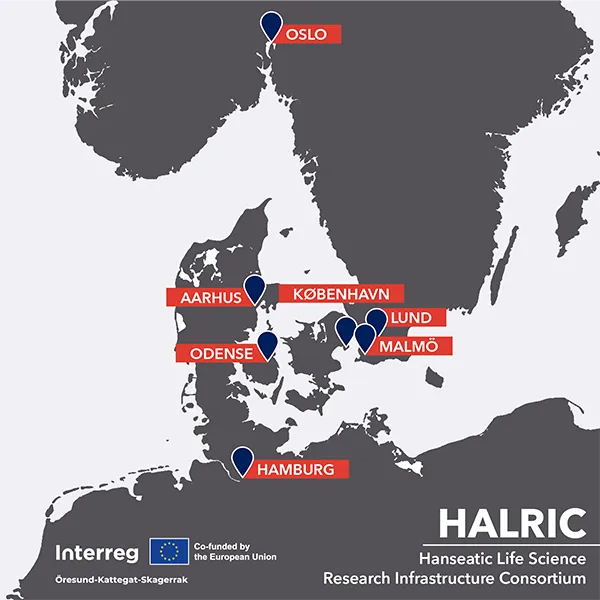The project provides an outstanding opportunity to access unique infrastructure and build scientific collaborations across southern Scandinavia and northern Germany. The aim is to encourage cooperation between academia, hospitals and biotech industry, as well as across scientific disciplines, by providing access to facilities and competencies. Sekulic says:
– Some of these research institutions have specialized equipment that we do not currently have here in Norway. One of the most exciting aspects of the project is the possibility of finding collaborations with people who have the skills and equipment you can’t otherwise access, but that you would like to employ for your project.
HALRIC provides grants for cross-border collaboration
Through HALRIC, you access not only equipment but also money to pay researchers to do the experiments and to travel for an exchange. HALRIC funds cross-border collaborative projects with a duration of 3-9 months. These are usually smaller projects that are building on ongoing research or could provide a basis for exploring new directions.

– What sets HALRIC funding apart from other similar funding opportunities, is that the cross-border grants support travel and 50% of a salary for researcher involved. This could be anyone, a Phd student, postdoc or an engineer, Sekulic explains.
It is important to emphasize that although travel and cross-border collaboration are necessary to qualify for the fellowship, researchers do not have to spend the entire duration of the fellowship at the host lab.
Norway has received funding for ten outgoing cross-border fellowships where UiO researchers will travel to collaborating partners to learn techniques and collect data. At the same time UiO will host five incoming fellowships from the network. This way, the fellowships provide access not only to specialized infrastructure in neighboring countries, but also expertise and the development of new collaborations across the region.
Data storage and sharing through Hanseatic Cloud
Infrastructures like HALRIC develop large amounts of data. In addition to providing access to infrastructure, HALRIC will offer much-needed experts in data processing, analysis and visualization, allowing secure cloud-based storage and transmission of data through the Hanseatic Cloud.
A great opportunity for Oslo to grow as a life science hub
Oslo has many exciting new life science developments ongoing that will expand the investment in the field. The Oslo Science City initiative will increase the number of life science facilities available in the Oslo area. Also, the establishment of the new Life Science building will offer even more research infrastructure. Sekulic encourages everyone at UiO to take advantage of the opportunities that HALRIC offers to strengthen Oslo and Norway as a leading life science hub.
– This is a good opportunity to build the expertise that we can bring to Norway and help strengthen Oslo Science City and the new Life Science building, Sekulic highlights.
– The new Life science building is not going to be just the sum of what exists at the moment, it is meant to be levelled up to get it to the same level as the other countries around us that are developing science cities. HALRIC provides a great opportunity to build the local expertise, through research collaborations and by exploiting the research infrastructure and expertise that is available in the neighboring countries, she emphasizes.
– So when HALRIC is completed in 2026, we will be ready to move into the building with the new knowledge on par with our neighbors and evolve from there.
Get to meet your future collaborators
The project is starting now in April with a kick-off meeting in Copenhagen on the 20th of April. This is a good opportunity to network, find potential collaborators and increase your own visibility.
Since the goal of the project is to increase collaboration across the countries, HALRIC will cover travel expenses, and this includes travel to workshops and the kick-off meeting. Anyone interested in joining the meeting in April 20th, should contact the organizers to ask about the process for this. Read more about the kickoff conference and register here.
About the HALRIC project
HALRIC stands for Hanseatic Life Science Research Infrastructure Consortium. The consortium has 21 institutions including universities, hospitals, public sector and private sector. It aims to increase research, collaboration and innovation across triple helix (academia – hospitals – industry) with emphasis on innovation in the ÖKS-Hamburg Region, spanning southern Norway, southern Sweden, Denmark and northern Germany. The University of Oslo is the only Norwegian participant in the project and will contribute with access to core facilities and expertise at the Faculty of Medicine and Faculty of Mathematics and Natural sciences.
The HALRIC project is co-funded by the EU through Interreg Öresund-Kattegat-Skagerrak.
The 21 partner organisations of HALRIC
Sweden: Lund University (project lead), MAX IV, ESS, Malmö University, Skåne University Hospital, Region Skåne, Medicon Village
Denmark: University of Copenhagen, Technical University of Denmark, Aarhus University, University of Southern Denmark, Rigshospitalet, Region Hovedstaden, Medicon Valley Alliance (project management)
Germany: University of Hamburg, DESY, European XFEL, EMBL, Universitätsklinikum Hamburg Eppendorf, City of Hamburg, Life Science Nord
Norway: University of Oslo
The two affiliated organisations:
* Danish Life Science Cluster and
* Capital Region of Denmark
